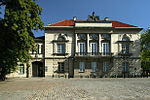Czapski Palace
1705 establishments in the Polish–Lithuanian CommonwealthAC with 0 elementsAcademy of Fine Arts in WarsawArt museums and galleries in PolandHouses completed in 1705 ... and 3 more
Palaces in WarsawRococo architecture in WarsawUniversities and colleges in Warsaw

The Czapski Palace (Polish: Pałac Czapskich, IPA: [ˈpawat͡s ˈt͡ʂapskʲix]), also called the Krasiński, Sieniawski or Raczyński Palace, is a substantial palace in the center of Warsaw, at 5 Krakowskie Przedmieście. It is considered one of the most distinguished examples of rococo architecture in Poland's capital. The building, just across the street from the University of Warsaw, has been home to famous persons including artist Zygmunt Vogel, composer Frédéric Chopin, and poets Zygmunt Krasiński and Cyprian Norwid. The palace now houses the Warsaw Academy of Fine Arts.
Excerpt from the Wikipedia article Czapski Palace (License: CC BY-SA 3.0, Authors, Images).Czapski Palace
Krakowskie Przedmieście, Warsaw Śródmieście (Warsaw)
Geographical coordinates (GPS) Address Website Nearby Places Show on map
Geographical coordinates (GPS)
| Latitude | Longitude |
|---|---|
| N 52.239444444444 ° | E 21.015833333333 ° |
Address
Akademia Sztuk Pięknych
Krakowskie Przedmieście 5
00-068 Warsaw, Śródmieście (Warsaw)
Masovian Voivodeship, Poland
Open on Google Maps











